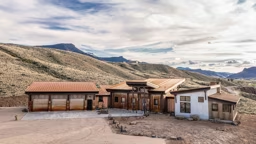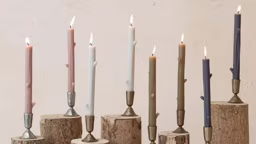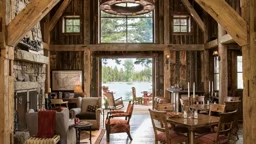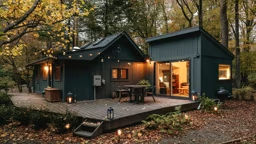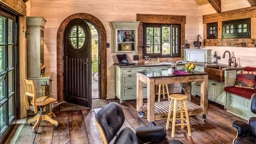The power’s out? Great!
As a kid, I loved it when we lost power during a storm because it meant using the fireplace instead of the furnace. I loved the scent of burning wood and watching the dancing flames.
Looking back, I realize the fireplace didn’t really do such a good job warming the house – but it sure was fun to sit beside the hearth.
A traditional fireplace, with its open-door system, is notorious for heat loss. That’s because it draws air (and heat) from the room. The fire burns quickly, which doesn’t give it time to get very hot and prevents the fuel from burning completely. Such inefficiency requires more fuel and creates more air pollution. Another downside to a traditional masonry fireplace is that it can be drafty when not being used.
The good news is that a lot has changed over the years and and there’s a better option than sealing off your fireplace: You can upgrade to an energy-efficient fireplace insert that burns wood, gas or pellets.
An insert is designed to fit inside an existing fireplace. The fireplace then becomes a closed-door system, which slows the burn rate. This increases the fire’s temperature, creating a hotter, more efficient heat source.
Is it hot enough for you?
Heat energy is measured in units of BTUs (British Thermal Units). The number of BTUs you’ll want your unit to generate depends on several factors, the biggest of which is: Will the stove insert be your primary heat source?
Square footage is another factor – as is airflow. Are there large obstructions, such as walls, that will prevent the heat from reaching certain areas? A slowly circulating ceiling fan near the heat source can move air throughout the home. The right combination of closed and opened doors throughout the cabin, also can help. Obviously, your needs will fluctuate during the year and even with the time of day.
Fuel for thought
When shopping for an insert, inquire about availability and cost of each fuel type. Some of the more common fuel choices are wood, gas and pellet. Propane may be the only choice for gas (as opposed to natural gas). Wood may be cheapest, but do you have the time and desire to cut, haul and split it yourself? Even if you have wood delivered, you still have to stack it and haul it inside.
While some pellet stoves can burn alternative materials such as corn kernels, most burn compressed wood that looks conspicuously like rabbit food. The pellets come in 40-pound bags, with some brands of pellets being dustier than others. (I speak from experience. When my grandmother used to transfer pellets from a big bag into smaller containers, the dust clouds would choke us both.)
The pellets are poured into a hopper where a corkscrew-shaped auger transfers them to the fire chamber. Most stoves will hold enough pellets to last all day. Some have thermostats that automate the feed rate according to the desired temperature.
If you’ve avoided gas fireplaces because you think they look too fake, think again. Gas fireplaces have come a long way since they were first introduced. Today’s gas logs can be almost indistinguishable from the real thing. And if you’re really into it, you can purchase realistic-looking bark chips, glowing embers and faux crackling pine cones.
For some people, the favorite gas fireplace insert accessory is the remote control. Without getting off the couch, you can turn on the fireplace, adjust the temperature, the flame height, or shut it off for the night. If you’re a channel flipper, just make sure you grab the right remote!
As a kid, I loved it when we lost power during a storm because it meant using the fireplace instead of the furnace. I loved the scent of burning wood and watching the dancing flames.
Looking back, I realize the fireplace didn’t really do such a good job warming the house – but it sure was fun to sit beside the hearth.
A traditional fireplace, with its open-door system, is notorious for heat loss. That’s because it draws air (and heat) from the room. The fire burns quickly, which doesn’t give it time to get very hot and prevents the fuel from burning completely. Such inefficiency requires more fuel and creates more air pollution. Another downside to a traditional masonry fireplace is that it can be drafty when not being used.
The good news is that a lot has changed over the years and and there’s a better option than sealing off your fireplace: You can upgrade to an energy-efficient fireplace insert that burns wood, gas or pellets.
An insert is designed to fit inside an existing fireplace. The fireplace then becomes a closed-door system, which slows the burn rate. This increases the fire’s temperature, creating a hotter, more efficient heat source.
Is it hot enough for you?
Heat energy is measured in units of BTUs (British Thermal Units). The number of BTUs you’ll want your unit to generate depends on several factors, the biggest of which is: Will the stove insert be your primary heat source?
Square footage is another factor – as is airflow. Are there large obstructions, such as walls, that will prevent the heat from reaching certain areas? A slowly circulating ceiling fan near the heat source can move air throughout the home. The right combination of closed and opened doors throughout the cabin, also can help. Obviously, your needs will fluctuate during the year and even with the time of day.
Fuel for thought
When shopping for an insert, inquire about availability and cost of each fuel type. Some of the more common fuel choices are wood, gas and pellet. Propane may be the only choice for gas (as opposed to natural gas). Wood may be cheapest, but do you have the time and desire to cut, haul and split it yourself? Even if you have wood delivered, you still have to stack it and haul it inside.
While some pellet stoves can burn alternative materials such as corn kernels, most burn compressed wood that looks conspicuously like rabbit food. The pellets come in 40-pound bags, with some brands of pellets being dustier than others. (I speak from experience. When my grandmother used to transfer pellets from a big bag into smaller containers, the dust clouds would choke us both.)
The pellets are poured into a hopper where a corkscrew-shaped auger transfers them to the fire chamber. Most stoves will hold enough pellets to last all day. Some have thermostats that automate the feed rate according to the desired temperature.
If you’ve avoided gas fireplaces because you think they look too fake, think again. Gas fireplaces have come a long way since they were first introduced. Today’s gas logs can be almost indistinguishable from the real thing. And if you’re really into it, you can purchase realistic-looking bark chips, glowing embers and faux crackling pine cones.
For some people, the favorite gas fireplace insert accessory is the remote control. Without getting off the couch, you can turn on the fireplace, adjust the temperature, the flame height, or shut it off for the night. If you’re a channel flipper, just make sure you grab the right remote!
A matter of style
Though classic black is ever popular, you can choose colors and designs to suit your style and room décor.
Surround the insert face with traditional cast iron or go for something special with a painted finish. Color and finish choices vary extensively by manufacturer.
Perhaps bay windows are your thing. An insert that extends onto the hearth can make for a dramatic flourish.
Doors can be either arched or straight, with clear or webbed glass fronts. Louvers and trim colors can match or offset the doorframe. Common choices are black, gold or nickel finishes.
When the power goes out
With winter and spring storms come the occasional power outages. When this happens on very cold days, you’ll be thankful that the disabled furnace is not the only thing standing between you and frozen pipes. While it’s true that the blower fan won’t work, your insert should generate enough heat to keep everybody (and the plumbing) toasty warm. Keep in mind that units regulated by computers, electric thermostats or automated pellet feeder devices will not work if the power goes out – unless they have a backup battery pack.
With so many insert options available, it makes sense to retrofit the old fireplace with an insert. Besides saving energy, it can transform the look of your home.
A fireplace insert can be just what it takes to make power outages fun again.
Freelance writer Jennifer Hawks is a cabin owner living in the Yukon.
Though classic black is ever popular, you can choose colors and designs to suit your style and room décor.
Surround the insert face with traditional cast iron or go for something special with a painted finish. Color and finish choices vary extensively by manufacturer.
Perhaps bay windows are your thing. An insert that extends onto the hearth can make for a dramatic flourish.
Doors can be either arched or straight, with clear or webbed glass fronts. Louvers and trim colors can match or offset the doorframe. Common choices are black, gold or nickel finishes.
When the power goes out
With winter and spring storms come the occasional power outages. When this happens on very cold days, you’ll be thankful that the disabled furnace is not the only thing standing between you and frozen pipes. While it’s true that the blower fan won’t work, your insert should generate enough heat to keep everybody (and the plumbing) toasty warm. Keep in mind that units regulated by computers, electric thermostats or automated pellet feeder devices will not work if the power goes out – unless they have a backup battery pack.
With so many insert options available, it makes sense to retrofit the old fireplace with an insert. Besides saving energy, it can transform the look of your home.
A fireplace insert can be just what it takes to make power outages fun again.
Freelance writer Jennifer Hawks is a cabin owner living in the Yukon.
Shopping for an insert?
• Work with a local home heating retailer to determine the best system for your needs.
• Take careful measurements of your fireplace. You’ll need to know the distance from the firebox to the mantel, the depth of the hearth, and the width and height in the rear of the fireplace. You also should note the front opening height, the opening width, and the depth from front to back and top to bottom.
• Before installing any type of insert, check with your insurance company for policy restrictions.
• Beyond fuel costs, consider the hidden costs of any insert: the amount of electricity it will use, if any (for blowers, start-up, etc.), delivery and installation fees, maintenance and annual inspections.
• For safety’s sake, experts recommend adding a metal chimney liner inside the chimney. Liners carry smoke and hot gases to the outside and prevent carbon monoxide from re-entering the cabin.
• Work with a local home heating retailer to determine the best system for your needs.
• Take careful measurements of your fireplace. You’ll need to know the distance from the firebox to the mantel, the depth of the hearth, and the width and height in the rear of the fireplace. You also should note the front opening height, the opening width, and the depth from front to back and top to bottom.
• Before installing any type of insert, check with your insurance company for policy restrictions.
• Beyond fuel costs, consider the hidden costs of any insert: the amount of electricity it will use, if any (for blowers, start-up, etc.), delivery and installation fees, maintenance and annual inspections.
• For safety’s sake, experts recommend adding a metal chimney liner inside the chimney. Liners carry smoke and hot gases to the outside and prevent carbon monoxide from re-entering the cabin.





